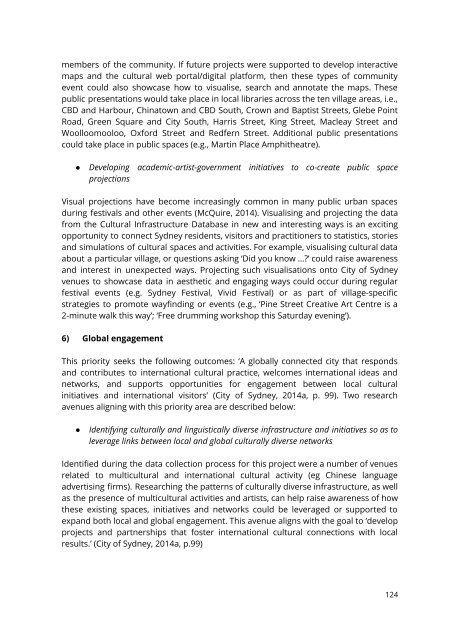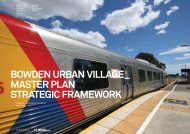MAPPING CULTURE
Mapping-Culture-Venues-and-Infrastructure-in-the-City-of-Sydney
Mapping-Culture-Venues-and-Infrastructure-in-the-City-of-Sydney
Create successful ePaper yourself
Turn your PDF publications into a flip-book with our unique Google optimized e-Paper software.
members of the community. If future projects were supported to develop interactive<br />
maps and the cultural web portal/digital platform, then these types of community<br />
event could also showcase how to visualise, search and annotate the maps. These<br />
public presentations would take place in local libraries across the ten village areas, i.e.,<br />
CBD and Harbour, Chinatown and CBD South, Crown and Baptist Streets, Glebe Point<br />
Road, Green Square and City South, Harris Street, King Street, Macleay Street and<br />
Woolloomooloo, Oxford Street and Redfern Street. Additional public presentations<br />
could take place in public spaces (e.g., Martin Place Amphitheatre).<br />
● Developing academic-artist-government initiatives to co-create public space<br />
projections<br />
Visual projections have become increasingly common in many public urban spaces<br />
during festivals and other events (McQuire, 2014). Visualising and projecting the data<br />
from the Cultural Infrastructure Database in new and interesting ways is an exciting<br />
opportunity to connect Sydney residents, visitors and practitioners to statistics, stories<br />
and simulations of cultural spaces and activities. For example, visualising cultural data<br />
about a particular village, or questions asking ‘Did you know …?’ could raise awareness<br />
and interest in unexpected ways. Projecting such visualisations onto City of Sydney<br />
venues to showcase data in aesthetic and engaging ways could occur during regular<br />
festival events (e.g. Sydney Festival, Vivid Festival) or as part of village-specific<br />
strategies to promote wayfinding or events (e.g., ‘Pine Street Creative Art Centre is a<br />
2-minute walk this way’; ‘Free drumming workshop this Saturday evening’).<br />
6) Global engagement<br />
This priority seeks the following outcomes: ‘A globally connected city that responds<br />
and contributes to international cultural practice, welcomes international ideas and<br />
networks, and supports opportunities for engagement between local cultural<br />
initiatives and international visitors’ (City of Sydney, 2014a, p. 99). Two research<br />
avenues aligning with this priority area are described below:<br />
●<br />
Identifying culturally and linguistically diverse infrastructure and initiatives so as to<br />
leverage links between local and global culturally diverse networks<br />
Identified during the data collection process for this project were a number of venues<br />
related to multicultural and international cultural activity (eg Chinese language<br />
advertising firms). Researching the patterns of culturally diverse infrastructure, as well<br />
as the presence of multicultural activities and artists, can help raise awareness of how<br />
these existing spaces, initiatives and networks could be leveraged or supported to<br />
expand both local and global engagement. This avenue aligns with the goal to ‘develop<br />
projects and partnerships that foster international cultural connections with local<br />
results.’ (City of Sydney, 2014a, p.99)<br />
124



